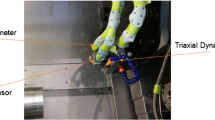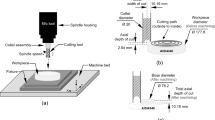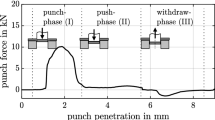Abstract
Machining processes are of considerable significance to industries such as aviation, power generation, oil, and gas since a significant part of the industrial mechanical components went through a machining process during its manufacturing. Therefore, using worn cutting tools can lead to operational interruptions, accidents, and potential economic losses during these processes. Concerning these consequences, real-time monitoring can result in cost reduction, along with productivity and safety increase. This paper aims to discuss an autonomous model based on the self-organized direction-aware data partitioning algorithm and machine learning techniques, including time series feature extraction based on scalable hypothesis tests, to solve this problem. The model proposed in this work was tested in a data set recorded in a real machining system at the Manufacturing Processes Laboratory of the Federal University of Juiz de Fora in collaboration with the Laboratory of Industrial Automation and Computational Intelligence. This model can identify the patterns that distinguish the cutting tool operations as adequate or inadequate, achieving satisfactory performances in all cases presented in this work and potentially allowing to prevent faulty pieces fabrication.









Similar content being viewed by others

References
Global Machine Tools Market (2019) Global machine tools market by product type (milling machines, drilling machines, turning machines, grinding machines, electrical discharge machines), automation type, industry segment, sales channel, and region—global forecast to 2027. https://www.marketsandmarkets.com/Market-Reports/machine-tools-market-168345068.html. Accessed 08 July 2021.
Market Prospects (2020) Overview of the global machine tool market prosperity in 2018. https://www.market-prospects.com/articles/overview-of-the-global-machine-tool-market. Accessed 08 July 2021.
Aghazadeh, F., Tahan, A., & Thomas, M. (2018). Tool condition monitoring using spectral subtraction and convolutional neural networks in milling process. The International Journal of Advanced Manufacturing Technology, 98(9), 3217–3227. https://doi.org/10.1007/s00170-018-2420-0
de Aguiar, E. P., Fernandes, T. E., Nogueira, FMd. A., Silveira, D. D., Vellasco, M. M. B. R., & Ribeiro, M. V. (2021). A new model to distinguish railhead defects based on set-membership type-2 fuzzy logic system. International Journal of Fuzzy Systems, 23(4), 1057–1069. https://doi.org/10.1007/s40815-020-00945-3
Altintas, Y. (1992). Prediction of cutting forces and tool breakage in milling from feed drive current measurements. Journal of Engineering for Industry, 114(4), 386–392. https://doi.org/10.1115/1.2900688
Altintas, Y., & Peng, J. (1990). Design and analysis of a modular CNC system. Computers in Industry, 13(4), 305–316. https://doi.org/10.1016/0166-3615(90)90003-8
Amorim, H. J. D. (2002). Estudo da relação entre velocidade de corte, desgaste de ferramenta, rugosidade e forças de usinagem em torneamento com ferramenta de metal duro. Universidade Federal do Rio Grande do Sul.
Angelov, P. (2014). Outside the box: An alternative data analytics framework. Journal of Automation, Mobile Robotics and Intelligent Systems, 8(2), 29–35.
Angelov, P., Gu, X., & Kangin, D. (2017). Empirical data analytics. International Journal of Intelligent Systems, 32(12), 1261–1284. https://doi.org/10.1109/SMC.2016.7844219
Angelov, P., Gu, X., & Príncipe, J. C. (2018). A generalized methodology for data analysis. IEEE Transactions on Cybernetics, 48(10), 2981–2993. https://doi.org/10.1109/TCYB.2017.2753880
Arisoy, Y. M., & Özel, T. (2015). Machine learning based predictive modeling of machining induced microhardness and grain size in Ti-6Al-4V alloy. Materials and Manufacturing Processes, 30(4), 425–433. https://doi.org/10.1080/10426914.2014.961476
Assarzadeh, S., & Ghoreishi, M. (2008). Neural-network-based modeling and optimization of the electro-discharge machining process. The International Journal of Advanced Manufacturing Technology, 39(5–6), 488–500. https://doi.org/10.1007/s00170-007-1235-1
Benkedjouh, T., Medjaher, K., Zerhouni, N., & Rechak, S. (2015). Health assessment and life prediction of cutting tools based on support vector regression. Journal of Intelligent Manufacturing, 26(2), 213–223. https://doi.org/10.1007/s10845-013-0774-6
Bishop, C. M. (2016). Pattern recognition and machine learning. Springer.
Blei, D. M., & Jordan, M. I. (2006). Variational inference for Dirichlet process mixtures. Bayesian Analysis, 1(1), 121–143. https://doi.org/10.1214/06-BA104
Caggiano, A. (2018). Tool wear prediction in Ti-6Al-4V machining through multiple sensor monitoring and PCA features pattern recognition. Sensors. https://doi.org/10.3390/s18030823
Caggiano, A., Angelone, R., Napolitano, F., Nele, L., & Teti, R. (2018). Dimensionality reduction of sensorial features by principal component analysis for ANN machine learning in tool condition monitoring of CFRP drilling. Procedia CIRP, 78, 307–312. https://doi.org/10.1016/j.procir.2018.09.072
Chang, Y. C., Lee, K. T., & Chuang, H. Y. (1995). Cutting force estimation of spindle motor. Journal of Control Systems and Technology, 3(2), 145–152.
Chen, Y., Jin, Y., & Jiri, G. (2018). Predicting tool wear with multi-sensor data using deep belief networks. The International Journal of Advanced Manufacturing Technology, 99(5), 1917–1926. https://doi.org/10.1007/s00170-018-2571-z
Chiu, S. L. (1994). Fuzzy model identification based on cluster estimation. Journal of Intelligent and Fuzzy Systems, 2(3), 267–278. https://doi.org/10.3233/IFS-1994-2306
Christ, M., Kempa-Liehr, A. W., & Feindt, M. (2016). Distributed and parallel time series feature extraction for industrial big data applications. CoRR abs/1610.07717. http://arxiv.org/abs/1610.07717
Christ, M., Braun, N., Neuffer, J., & Kempa-Liehr, A. W. (2018). Time series feature extraction on basis of scalable hypothesis tests (tsfresh–a python package). Neurocomputing, 307, 72–77. https://doi.org/10.1016/j.neucom.2018.03.067
Comaniciu, D., & Meer, P. (2002). Mean shift: A robust approach toward feature space analysis. IEEE Transactions on Pattern Analysis and Machine Intelligence, 24(5), 603–619.
Dimla, E. D. (2000). Sensor signals for tool-wear monitoring in metal cutting operations–A review of methods. International Journal of Machine Tools Manufacture, 40(8), 1073–1098. https://doi.org/10.1016/S0890-6955(99)00122-4
Dovžan, D., & Š I, (2011). Recursive clustering based on a Gustafson-Kessel algorithm. Evolving Systems, 2(1), 15–24.
Ester, M., Kriegel, H. P., Sander, J., Xu, X., et al. (1996). A density-based algorithm for discovering clusters in large spatial databases with noise. In kdd (Vol. 96, pp. 226–231).
Fernandes, T. E., & de Aguiar, E. P. (2021). A new model to prevent failures in gas turbine engines based on tsfresh, self-organized direction aware data partitioning algorithm and machine learning techniques. Journal of the Brazilian Society of Mechanical Sciences and Engineering. https://doi.org/10.1007/s40430-021-02956-z
Franti, P., Virmajoki, O., & Hautamaki, V. (2008). Probabilistic clustering by random swap algorithm. In 2008 19th international conference on pattern recognition (pp. 1–4). https://doi.org/10.1109/ICPR.2008.4761798.
Frey, B. J., & Dueck, D. (2007). Clustering by passing messages between data points. Science, 315(5814), 972–976. https://doi.org/10.1126/science.1136800
Gouarir, A., Martinez-Arellano, G., Terrazas, G., Benardos, P., & Ratchev, S. (2018). In-process tool wear prediction system based on machine learning techniques and force analysis. 8th CIRP Conference on High Performance Cutting Procedia CIRP, 77, 501–504. https://doi.org/10.1016/j.procir.2018.08.253 (HPC 2018).
Gu, X., Angelov, P. P., Kangin, D., & Principe, J. C. (2018). Self-organised direction aware data partitioning algorithm. Information Sciences, 423, 80–95. https://doi.org/10.1016/j.ins.2017.09.025
Hossain, M. I., Amin, A. K. M. N., & Patwari, A. U. (2008). Development of an artificial neural network algorithm for predicting the surface roughness in end milling of inconel 718 alloy. https://doi.org/10.1109/ICCCE.2008.4580819.
Huang, P. B., Ma, C. C., & Kuo, C. H. (2015). A PNN self-learning tool breakage detection system in end milling operations. Applied Soft Computing, 37(1), 114–124. https://doi.org/10.1016/j.asoc.2015.08.019
Hyde, R., Angelov, P., & MacKenzie, A. (2017). Fully online clustering of evolving data streams into arbitrarily shaped clusters. Information Sciences, 382–383, 96–114. https://doi.org/10.1016/j.ins.2016.12.004
Jang, D. Y., Jung, J., & Seok, J. (2016). Modeling and parameter optimization for cutting energy reduction in MGL milling process. International Journal of Precision Engineering and Manufacturing-Green Technology, 3(1), 5–12. https://doi.org/10.1007/s40684-016-0001-y
Jolliffe, I. T. (1986). Principal component analysis and factor analysis. New York: Springer. https://doi.org/10.1007/978-1-4757-1904-8_7
Jolliffe, I. T., & Cadima, J. (2016). Principal component analysis: A review and recent developments. Philosophical Transactions of the Royal Society A: Mathematical, Physical and Engineering Sciences, 374(2065), 1471–2962. https://doi.org/10.1098/rsta.2015.0202
Kim, T. Y., & Kim, J. (1996). Adaptive cutting force control for a machining center by using indirect cutting force measurements. International Journal of Machine Tools and Manufacture, 36(8), 925–937. https://doi.org/10.1016/0890-6955(96)00097-1
Kong, D., Chen, Y., & Li, N. (2018). Gaussian process regression for tool wear prediction. Mechanical Systems and Signal Processing, 104, 556–574. https://doi.org/10.1016/j.ymssp.2017.11.021
Krishnakumar, P., Rameshkumar, K., & Ramachandran, K. I. (2018). Acoustic emission-based tool condition classification in a precision high-speed machining of titanium alloy: A machine learning approach. International Journal of Computational Intelligence and Applications. https://doi.org/10.1142/S1469026818500177
Lee, J. M., Choi, D. K., Kim, J., & Chu, C. N. (1995). Real-time tool breakage monitoring for NC milling process. CIRP Annals, 44(1), 59–62. https://doi.org/10.1016/S0007-8506(07)62275-6
Lee, Y. K., Mavris, D. N., Volovoi, V. V., Yuan, M., & Fisher, T. (2010). A fault diagnosis method for industrial gas turbines using Bayesian data analysis. Journal of Engineering for Gas Turbines and Power. https://doi.org/10.1115/1.3204508
Li, J., Ray, S., & Lindsay, B. G. (2007). A nonparametric statistical approach to clustering via mode identification. Journal of Machine Learning Research, 8(59), 1687–1723.
Li, W., & Liu, T. (2019). Time varying and condition adaptive hidden Markov model for tool wear state estimation and remaining useful life prediction in micro-milling. Mechanical Systems and Signal Processing, 131, 689–702. https://doi.org/10.1016/j.ymssp.2019.06.021
Li, X., Djordjevich, A., & Venuvinod, P. K. (2000). Current-sensor-based feed cutting force intelligent estimation and tool wear condition monitoring. IEEE Transactions on Industrial Electronics, 47(3), 697–702. https://doi.org/10.1109/41.847910
Li, X., Zhang, W., Ding, Q., & Sun, J. Q. (2020). Intelligent rotating machinery fault diagnosis based on deep learning using data augmentation. Journal of Intelligent Manufacturing, 31(2), 433–452. https://doi.org/10.1007/s10845-018-1456-1
Liu, R., Kothuru, A., & Zhang, S. (2020). Calibration-based tool condition monitoring for repetitive machining operations. Journal of Manufacturing Systems, 54, 285–293. https://doi.org/10.1016/j.jmsy.2020.01.005
Niu, B., Sun, J., & Yang, B. (2020). Multisensory based tool wear monitoring for practical applications in milling of titanium alloy. Materials Today: Proceedings, 22, 1209–1217. https://doi.org/10.1016/j.matpr.2019.12.126
Oktem, H., Erzurumlu, T., & Erzincanli, F. (2006). Prediction of minimum surface roughness in end milling mold parts using neural network and genetic algorithm. Materials and Design, 27(9), 735–744. https://doi.org/10.1016/j.matdes.2005.01.010
Ou, J., Li, H., Huang, G., & Zhou, Q. (2020). A novel order analysis and stacked sparse auto-encoder feature learning method for milling tool wear condition monitoring. Sensors. https://doi.org/10.3390/s20102878
Panda, S. S., & Mahapatra, S. S. (2009). PCA fused NN approach for drill wear prediction in drilling mild steel specimen. In 2009 2nd IEEE international conference on computer science and information technology (pp. 85–89). IEEE, Beijing, China. https://doi.org/10.1109/ICCSIT.2009.5234475.
Pedregosa, F., Varoquaux, G., Gramfort, A., Michel, V., Thirion, B., Grisel, O., Blondel, M., Prettenhofer, P., Weiss, R., Dubourg, V., & J, Vanderplas, Passos A, Cournapeau D, Brucher M, Perrot M, Duchesnay E, (2011). Scikit-learn: Machine learning in python. Journal of Machine Learning Research, 12(85), 2825–2830.
Pontes, F. J., Paiva, A. P. D., Balestrassi, P. P., Ferreira, J. R., & Silva, M. B. D. (2012). Optimization of radial basis function neural network employed for prediction of surface roughness in hard turning process using Taguchi’s orthogonal arrays. Expert Systems with Applications, 39(9), 7776–7787. https://doi.org/10.1016/j.eswa.2012.01.058
Radivojac, P., Obradovic, Z., Dunker, A. K., & Vucetic, S. (2004). Feature selection filters based on the permutation test. In European conference on machine learning (Vol. 3201, pp. 334–346). Springer, Berlin, DE. https://doi.org/10.1007/978-3-540-30115-8_32.
Shao, H., Wang, H. L., & Zhao, X. (2004). A cutting power model for tool wear monitoring in milling. International Journal of Machine Tools and Manufacture, 44(14), 1503–1509. https://doi.org/10.1016/j.ijmachtools.2004.05.003
Shumway, R. H., & Stoffer, D. S. (2000). Time series analysis and its applications (Vol. 3). Springer. https://doi.org/10.1007/978-1-4757-3261-0.
Song, W., Di Matteo, T., & Aste, T. (2012). Hierarchical information clustering by means of topologically embedded graphs. PloS One, 7(3), e31929. https://doi.org/10.1371/journal.pone.0031929
Stein, J. L., Colvin, D., Clever, G., & Wang, C. H. (1986). Evaluation of dc servo machine tool feed drives as force sensors. Journal of Dynamic Systems, Measurement, and Control, 108(4), 279–288. https://doi.org/10.1115/1.3143795
Sun, H., Zhang, J., Mo, R., & Zhang, X. (2020). In-process tool condition forecasting based on a deep learning method. Robotics and Computer-Integrated Manufacturing, 64, 101924. https://doi.org/10.1016/j.rcim.2019.101924
Trent, E. M., & Wright, P. K. (2015). Metal cutting. Amsterdam: Butterworth-Heinemann.
Viswanath, P., & Suresh Babu, V. (2009). Rough-dbscan: A fast hybrid density based clustering method for large data sets. Pattern Recognition Letters, 30(16), 1477–1488. https://doi.org/10.1016/j.patrec.2009.08.008
Wang, C. D., Lai, J. H., Huang, D., & Zheng, W. S. (2013). Svstream: A support vector-based algorithm for clustering data streams. IEEE Transactions on Knowledge and Data Engineering, 25(6), 1410–1424. https://doi.org/10.1109/TKDE.2011.263
Wilcox, R. (2005). Kolmogorov-Smirnov test. Encyclopedia of Biostatistics. https://doi.org/10.1002/0470011815.b2a15064
Wu, D., Jennings, C., Terpenny, J., Gao, R. X., & Kumara, S. (2017). A comparative study on machine learning algorithms for smart manufacturing: tool wear prediction using random forests. Journal of Manufacturing Science and Engineering. https://doi.org/10.1115/1.4036350
Yuan, J., Wang, K., Yu, T., & Fang, M. (2008). Reliable multi-objective optimization of high-speed WEDM process based on Gaussian process regression. International Journal of Machine Tools and Manufacture, 48(1), 47–60. https://doi.org/10.1016/j.ijmachtools.2007.07.011
Zhou, C., Yang, B., Guo, K., Liu, J., Sun, J., Song, G., et al. (2020). Vibration singularity analysis for milling tool condition monitoring. International Journal of Mechanical Sciences, 166, 105254. https://doi.org/10.1016/j.ijmecsci.2019.105254
Çaydaş, U., & Hasşalık, A. (2008). A study on surface roughness in abrasive waterjet machining process using artificial neural networks and regression analysis method. Journal of Materials Processing Technology, 202(1–3), 574–582. https://doi.org/10.1016/j.jmatprotec.2007.10.024
Özel, T., Karpat, Y., Figueira, L., & Davim, J. P. (2007). Modelling of surface finish and tool flank wear in turning of AISI d2 steel with ceramic wiper inserts. Journal of Materials Processing Technology, 189(1–3), 192–198. https://doi.org/10.1016/j.jmatprotec.2007.01.021
Acknowledgements
The authors would like to acknowledge the Coordination for the Improvement of Higher Education Personnel—Brazil (CAPES)—Financing Code 001, National Council for Scientific and Technological Development—CNPq (process 433389/2018-4), Minas Gerais State Research Support Foundation—FAPEMIG (APQ-02922-18) and Federal University of Juiz de Fora—UFJF for financial support. An early version of paper was presented at XXIII Congresso Brasileiro de Automática (CBA 2020).
Author information
Authors and Affiliations
Corresponding author
Additional information
Publisher's Note
Springer Nature remains neutral with regard to jurisdictional claims in published maps and institutional affiliations.
Appendix: Critical Values for the Kolmogorov–Smirnov test
Appendix: Critical Values for the Kolmogorov–Smirnov test
See Table 5.
Rights and permissions
About this article
Cite this article
Fernandes, T.E., Ferreira, M.A.M., Miranda, G.P.C.d. et al. Classification of Lathe’s Cutting Tool Wear Based on an Autonomous Machine Learning Model. J Control Autom Electr Syst 33, 167–182 (2022). https://doi.org/10.1007/s40313-021-00819-5
Received:
Revised:
Accepted:
Published:
Issue Date:
DOI: https://doi.org/10.1007/s40313-021-00819-5



